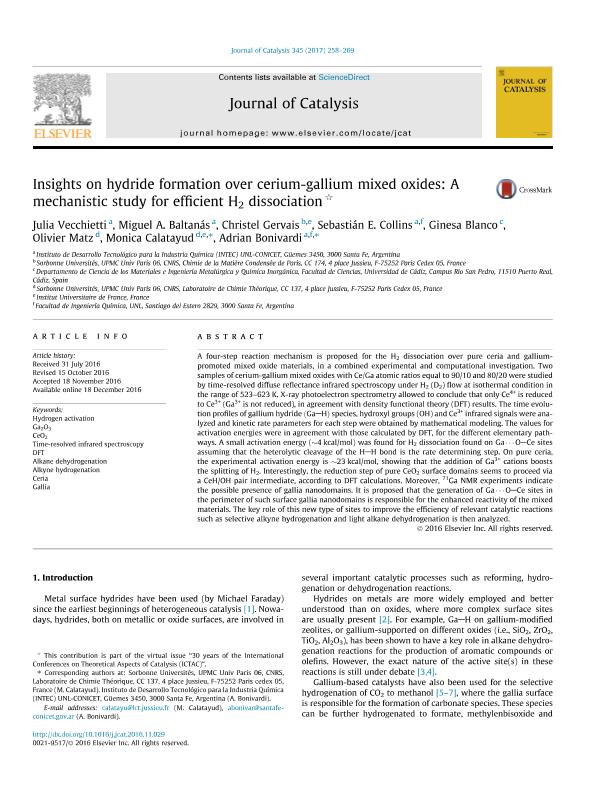Artículo
Insights on hydride formation over cerium-gallium mixed oxides: a mechanistic study for efficient H2 dissociation
Vecchietti, María Julia ; Baltanas, Miguel Angel
; Baltanas, Miguel Angel ; Gervais, Christel; Collins, Sebastián Enrique
; Gervais, Christel; Collins, Sebastián Enrique ; Blanco. Ginesa; Matz, Olivier; Calatayud, Monica; Bonivardi, Adrian Lionel
; Blanco. Ginesa; Matz, Olivier; Calatayud, Monica; Bonivardi, Adrian Lionel
 ; Baltanas, Miguel Angel
; Baltanas, Miguel Angel ; Gervais, Christel; Collins, Sebastián Enrique
; Gervais, Christel; Collins, Sebastián Enrique ; Blanco. Ginesa; Matz, Olivier; Calatayud, Monica; Bonivardi, Adrian Lionel
; Blanco. Ginesa; Matz, Olivier; Calatayud, Monica; Bonivardi, Adrian Lionel
Fecha de publicación:
01/2017
Editorial:
Elsevier
Revista:
Journal of Catalysis
ISSN:
0021-9517
Idioma:
Inglés
Tipo de recurso:
Artículo publicado
Clasificación temática:
Resumen
A four-step reaction mechanism is proposed for the H2 dissociation over pure ceria and Gallium promoted mixed oxide materials, in a combined experimental and computational investigation. Two samples of cerium-gallium mixed oxides with Ce/Ga atomic ratios equal to 90/10 and 80/20 were studied by time-resolved diffuse reflectance infrared spectroscopy under H2 (D2) flow at isothermal condition in the range of 523?623 K. X-ray photoelectron spectrometry allowed to conclude that only Ce4+ is reduced to Ce3+ (Ga3+ is not reduced), in agreement with density functional theory (DFT) results. The time evolution profiles of gallium hydride ðGaAHÞ species, hydroxyl groups (OH) and Ce3+ infrared signals were analyzed and kinetic rate parameters for each step were obtained by mathematical modeling. The values for activation energies were in agreement with those calculated by DFT, for the different elementary pathways. A small activation energy (4 kcal/mol) was found for H2 dissociation found on GaOCe sites assuming that the heterolytic cleavage of the HAH bond is the rate determining step. On pure ceria, the experimental activation energy is 23 kcal/mol, showing that the addition of Ga3+ cations boosts the splitting of H2. Interestingly, the reduction step of pure CeO2 surface domains seems to proceed via a CeH/OH pair intermediate, according to DFT calculations. Moreover, 71Ga NMR experiments indicate<br />the possible presence of gallia nanodomains. It is proposed that the generation of Ga OACe sites in the perimeter of such surface gallia nanodomains is responsible for the enhanced reactivity of the mixed materials. The key role of this new type of sites to improve the efficiency of relevant catalytic reactions such as selective alkyne hydrogenation and light alkane dehydrogenation is then analyzed.
Palabras clave:
Hydrogen Activation
,
Catalysis
,
Surfaces
,
Infrared
Archivos asociados
Licencia
Identificadores
Colecciones
Articulos(INTEC)
Articulos de INST.DE DES.TECNOL.PARA LA IND.QUIMICA (I)
Articulos de INST.DE DES.TECNOL.PARA LA IND.QUIMICA (I)
Citación
Vecchietti, María Julia; Baltanas, Miguel Angel; Gervais, Christel; Collins, Sebastián Enrique; Blanco. Ginesa; et al.; Insights on hydride formation over cerium-gallium mixed oxides: a mechanistic study for efficient H2 dissociation; Elsevier; Journal of Catalysis; 345; 1-2017; 258-269
Compartir
Altmétricas



